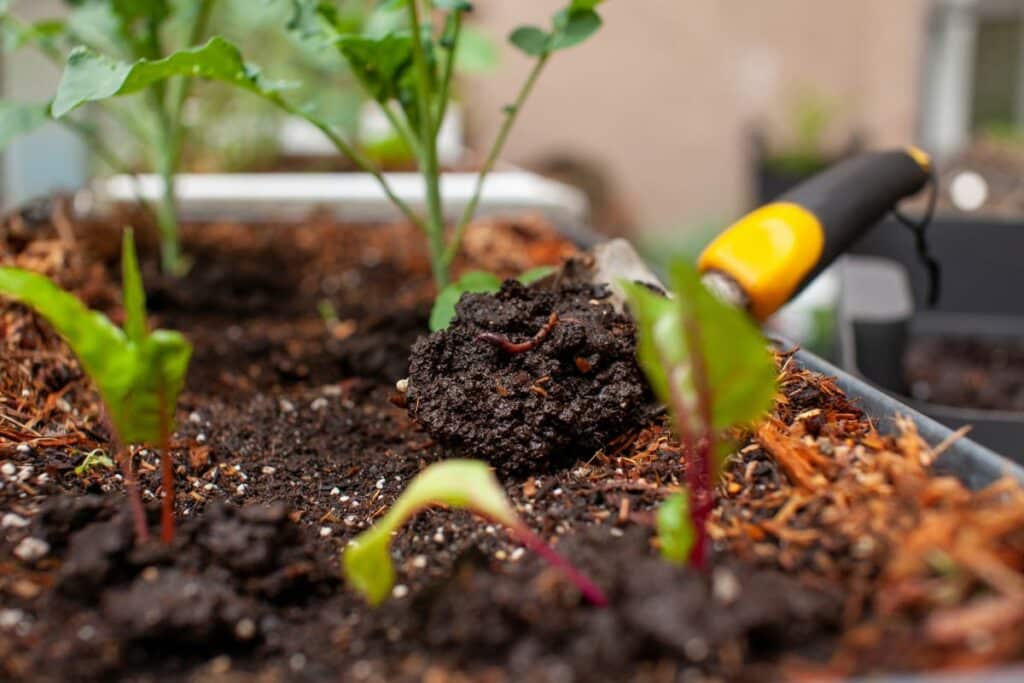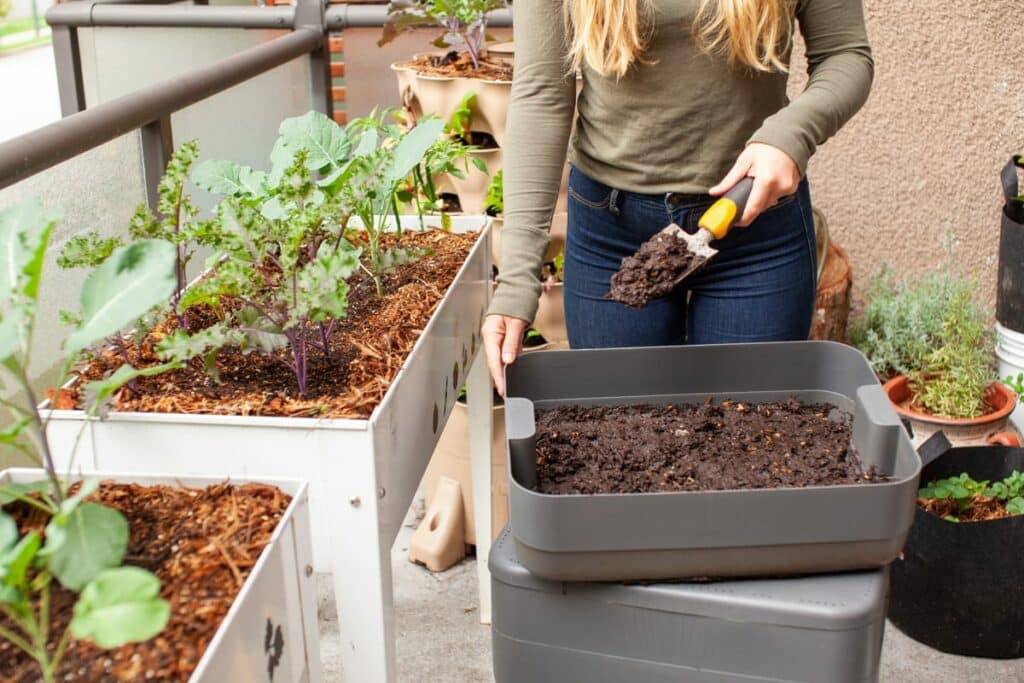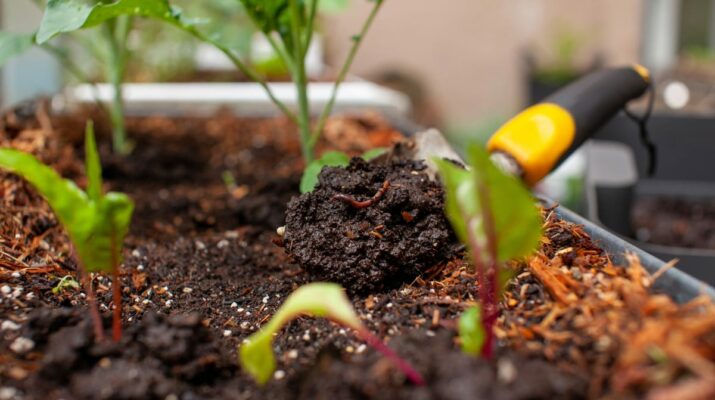
Using worm castings in the garden is getting more popular by the day—so much so that the vermicompost market was estimated at $85.77 billion in 2022 and is only expected to grow in the upcoming years.
What is it about worm manure that attracts this kind of buzz, and how can you use it in your garden? Let’s find out!
Why Are Worm Castings Good for Plants?
The short answer is that the vermicompost is full of nutrients, microorganisms (the good kind), and enzymes. These aspects improve soil’s chemical, physical, and biological properties, which ultimately reflects on plant growth.
However, if you’re looking for the details, take a look at the following reasons that make worm castings so beneficial:
1. They’re Humus-Rich
The beauty of worm castings is that they’re chock full of organic matter or what the folks with green thumbs call “humus.” In fact, the soil mix can end up with up to 10 times more organic matter.
It’s hard to estimate the exact NPK ratio since it might vary based on the worm’s diet, but you can expect something around 5:5:3. Plus, you’ll get a decent dose of iron, calcium, and sulfur.
That said, the castings are here for the long game.
Just think of worm manure as a slow-release organic fertilizer. However, the mechanism is a bit different.
Your typical store-bought fertilizer relies on stuff like plastic resins that break down with time to control the flow of nutrients to the soil. Meanwhile, each casting is coated with a protective layer before it comes out of the worm’s body. This coat is what mimics the slow-release effect.
The bonus point here is that worm manure contains humic acids. Those help the plants take up the nutrients.
2. They Don’t Burn Plants
We know what you’re thinking: animal manure and commercially sold fertilizer bags are also nutrient-rich, so what makes worm castings special?
Well, you’d have to compost manure from, say, chicken for 5–6 weeks before using it around the garden. Similarly, a store-bought nitrogen-rich fertilizer can burn your plants if you’re not careful with the dilution and frequency.
That’s not an issue at all with worm castings. They won’t burn your plants, even if you use them straight out of the bin.
3. They Enrich the Soil’s Biodiversity
A handful of worm castings brings more than just humus and macronutrients to the table—the microbial diversity is a game-changer!
For one, the castings are rich in nematodes, protozoa, and even beneficial bacteria that fix nitrogen in the soil, but that’s not all.
The compost can also feed the bacteria that are already in the soil, boosting their population.
4. They Ward off Diseases
As it happens, the microbial community in the worm castings can do more than just nitrogen fixation.
Recent research shows it can protect germinating seeds from Pythium infections. The exact mechanisms aren’t clear, but it seems like the beneficial microbes in the vermicompost cover up the seed’s surface and interfere with the chemical signal between the host and the pathogen.
Either way, we’ll see how you can put that concept into action in a minute!
But it’s not only the seed that benefits from the worm castings’ disease-warding potential.
Some experts believe that worm manure contains an enzyme called chitinase. That’s an enzyme that targets the glycosidic bonds in chitin polymers.
We’ll spare you the long, dry science: chitinase breaks down the exoskeleton part of pests like white flies.
5. They Boost the Soil Structure
Aside from contributing to the soil’s biodiversity and nutrient content, worm manure also helps improve the structural aspects.
For one, it has a high water-holding capacity thanks to its high organic matter content. Plus, it helps with ventilation.
Keep in mind that you might hear about how some earthworms burrow tunnel networks underground, which eventually helps with aeration.
While that’s true, it’s not what we’re talking about here. In fact, those worms aren’t even the epigeic type that people farm for compost.

What Are Worm Castings Good for?
Worm castings make effective fertilizers, both dry and liquid. Depending on how much compost you have and your gardening needs, you can use the casings as a top dressing, soil amendment component, starting mix component, or worm tea.
Top Dressing
Let’s start with the most hassle-free use: top-dressing.
All you have to do here is grab the black gold as it is (no dilution or curing needed) and sprinkle it over the soil, going around the plant’s base. For plants over 6 weeks old, go for a 1-inch layer for every 2–3 inches of the plant’s height.
Then, you can slowly water the area to start releasing the nutrients. Just make sure the water pressure isn’t intense enough to scatter the castings away from the plant.
Mostly, we see people using this method for flower beds, shrubs, and even vegetables. However, it’s possible to use it for larger surfaces, like a lawn, for instance. In this case, UCANR recommends top-dressing at 4 pounds of castings to 100 square feet.
Soil Amendment
If you’re looking for a deeper fix to your soil problems, consider mixing the worm manure into the soil to “amend” its flaws and improve water retention.
Yes, this method takes more castings than the previous one, but it helps distribute the humus throughout the growing medium.
This approach will work both in-ground or for a potted plant, and 5–20% by volume usually does the trick.
Starting Mix
Remember when we said that worm castings could protect seeds from Pythium infections? Well, that’s one compelling reason to use vermicompost in your starting mix.
For instance, if you’re growing vegetables, you can use a blend of equal parts vermiculite and castings. However, you might need touches of alfalfa, kelp meal, phosphate rock, and a full-spectrum micro-nutrient supplement for soil amendment.
Worm Tea
Since the castings are highly water-soluble, why not turn them into liquid fertilizer for faster action?
Keep in mind that this is different from the leachate that collects in a wormery’s drainage tray. The tea is safer but requires more effort on your part.
Here’s what you’ll need to do:
- Dump the castings into a stocking or cloth bag.
- Fill a large bucket with non-chlorinated water.
- Close the bag and put it in the bucket.
- Use an aerator to circulate oxygen in the bucket. (optional)
- Let it sit for 1–2 days in a sunny spot to brew.
Although step number four is optional, we’d highly recommend sticking to it. After all, research shows that aeration stabilizes the tea and boosts its efficiency. If you don’t have an aerator, at least stir the bucket frequently as it brews.
When you’re all done, dilute the tea to 50% with filtered water and pour some over the soil or the whole plant.
Are There Any Drawbacks to Using Worm Castings in the Garden?
Unfortunately, nothing is perfect—not even vermicompost.
The main drawbacks to consider are:
- Low Production Rates: You can only harvest the castings every 4 months or so.
- Overuse Caution: Although it’s virtually impossible to burn established plants, you’ll want to reduce the amount used for plants younger than 6 weeks.
- Volunteer Seeds: If you feed your worms vegetables or fruits, you have to sift the seeds out of the vermicompost to avoid random sprouting in starting mixes.
The Bottom Line
Whether you’re looking for a nutrient boost, structural improvements, or some protection against pests and infections, worm compost has got your back.
It might not eliminate the need for fertilizers altogether, but it’s a step toward sustainable gardening!

